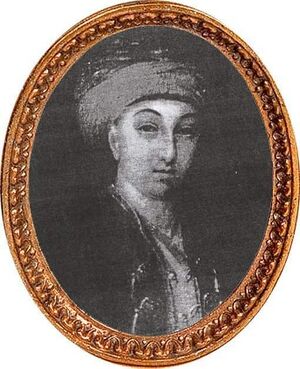قائمة ولاة مصر العثمانيين
قائمة الولاة مصر العثمانيين.
| # | الحاكم | بدأ | إنتهى | اللقب | هوامش الهوية[N 1] | هوامش الحكم | ||
|---|---|---|---|---|---|---|---|---|
| 1 | يونس باشا | 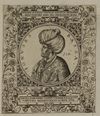
|
1517 | 1517 | بايلربك | [1][2] | Governorship revoked for corruption | |
| 2 | خاير باشا | الصورة غير متوافرة | 1517 | 1522 | بايلربك | [1][2][3][4] | Died in office | |
| 3 | جوبان مصطفى باشا | الصورة غير متوافرة | 1522 | 1523 | بايلربك | [1][2][5][6][7] | Put down a small Mamluk revolt[3] | |
| 4 | أحمد باشا الخائن | الصورة غير متوافرة | 1523 | 1524 | سلطان | [1][2][3][7] | تمرد، وأعلن نفسه سلطانا؛ فأُعدِم[3][7] | |
| 5 | كوزلجه باشا (فترة 1) | الصورة غير متوافرة | 1524 | 1525 | بايلربك | [1][2][8] | ||
| 6 | پارگالي ابراهيم باشا | 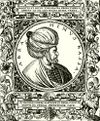
|
1525 | 1525 | بايلربك | [1][9] | بقي في المنصب لثلاثة أشهر، نظّم خلالها النظام المدني والعسكري لمصر العثمانية[9] | |
| 7 | كوزلجه باشا (فترة 2) | الصورة غير متوافرة | 1525 | 1525 | بايلربك | [1][2] | ||
| 8 | سليمان باشا الخادم (فترة 1) | الصورة غير متوافرة | 1525 | 1535 | بايلربك | [1][2] | ||
| 9 | Divane Hüsrev Pasha | الصورة غير متوافرة | 1535 | 1537 | بايلربك | [1][2] | ||
| 10 | سليمان باشا الخادم (فترة 2) | الصورة غير متوافرة | 1537 | 1538 | بايلربك | [1][2] | ||
| 11 | داود باشا | الصورة غير متوافرة | 1538 | 1549 | بايلربك | [1][2][10] | Long-standing feud with Rüstem Pasha;[10] died in office | |
| لالة قرة مصطفى باشا | 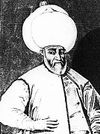
|
1549 | 1549 | قائمقام | [11][12] | Served only a few months[12] as acting governor[11] | ||
| 12 | علي باشا سميز | الصورة غير متوافرة | 1549 | 1554 | بايلربك | [1][2][10] | Appointed to another position in Constantinople | |
| 13 | محمد باشا دوكاكينزاد | الصورة غير متوافرة | 1554 | 1556 | بايلربك | [1][2][13][14] | Used to sing in public with a guitar; executed for violating sharia[13] | |
| 14 | إسكندر باشا | الصورة غير متوافرة | 1556 | 1559 | بايلربك | [1][2][14][15] | Had many public works built between Bab Zuweila and Bab al-Khalq[16] | |
| 15 | صوفو علي باشا الخادم | الصورة غير متوافرة | 1559 | 1560 | بايلربك | [1][2][17] | Also known as Sufi Ali Pasha[17] or Hadım Ali Pasha[1][2] | |
| 16 | قرة شاهين مصطفى باشا | الصورة غير متوافرة | 1560 | 1563 | بايلربك | [1][2][18] | Founder of the Ridwan dynasty, former governor of Gaza | |
| 17 | ميزينزاد علي باشا | 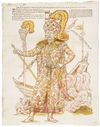
|
1563 | 1566 | بايلربك | [1][2][13] | Also known as Sufi or Sofu Ali Pasha[13] | |
| 18 | محمود باشا | الصورة غير متوافرة | 1566 | 1567 | بايلربك | [19][20] | Built the Mosque of Mahmud Pasha and assassinated in office by gunfire[20] | |
| 19 | خوجة سنان باشا (فترة 1) | 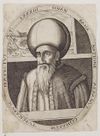
|
1567 | 1569 | بايلربك | [1][2][10] | ||
| 20 | جركس باشا | الصورة غير متوافرة | 1569 | 1571 | بايلربك | [1][2][21][22][23] | Known locally as al-Faqih, "the jurist"[24] | |
| 21 | خوجة سنان باشا (فترة 2) | 
|
1571 | 1573 | بايلربك | [1][2][10] | ||
| 22 | حسين باشا | الصورة غير متوافرة | 1573 | 1574 | بايلربك | [1][25][26][27] | Of a mild disposition, but thieves multiplied during his short term[25] | |
| 23 | مسيح باشا الخادم | الصورة غير متوافرة | 1574 | 1580 | بايلربك | [1][2][13][25] | Put to death many thieves, stunting robbery in the region for centuries[25] | |
| 24 | حسين باشا الخادم | الصورة غير متوافرة | 1580 | 1583 | بايلربك | [1][2][28] | Jailed in Constantinople[28] | |
| 25 | دماط ابراهيم باشا | الصورة غير متوافرة | 1583 | 1585 | بايلربك | [1][2] | ||
| 26 | سنان باشا دفتردار | الصورة غير متوافرة | 1585 | 1587 | بايلربك | [1][2][3][29] | Dismissed after being unable to collect enough taxes[29] | |
| 27 | Kara Üveys Pasha (de) | الصورة غير متوافرة | 1587 | 1590 | بايلربك | [3][30][31][note 1] | Died in office[31] | |
| 28 | حافظ أحمد باشا الخادم | الصورة غير متوافرة | 1590 | 1594 | بايلربك | [1][2] | Appointed governor of Bursa | |
| 29 | كرد محمد باشا | الصورة غير متوافرة | 1594 | 1596 | بايلربك | [1][2] | ||
| 30 | عنبر محمد محمد باشا | الصورة غير متوافرة | 1596 | 1598 | بايلربك | [1][2][21][24][32][33] | Known as al-Sharif and seyyid, often visited the Al-Hussein Mosque[24] | |
| 31 | خضر باشا | الصورة غير متوافرة | 1598 | 1601 | بايلربك | [1][2][33][34] | ||
| 32 | ياڤوز علي باشا | الصورة غير متوافرة | 1601 | 1603 | بايلربك | [1][2][33][35][36][note 2] | Appointed as grand vizier[35][36] | |
| 33 | ابراهيم حقي باشا المقتول | الصورة غير متوافرة | 1604 | 1604 | بايلربك | [1][2][33][37][38] | Murdered in a sepahi mutiny[39][40][41] | |
| 34 | محمد باشا الخادم | الصورة غير متوافرة | 1604 | 1605 | بايلربك | [1][33][41][note 3] | Attempted to get the mutiny under control, but failed[41] | |
| 35 | حسن يمنلي باشا | الصورة غير متوافرة | 1605 | 1607 | بايلربك | [1][2][33][42][43] | Previously the بايلربك of Yemen Eyalet (1580–1604)[42][43] | |
| 36 | محمد أوقوز باشا | الصورة غير متوافرة | 1607 | 1611 | بايلربك | [1][2][33][44][45][46][47] | Known as "kul kıran" (slavebreaker) for putting down sipahi mutiny[44][45][46][47] | |
| 37 | محمد صوفو باشا | الصورة غير متوافرة | 1611 | 1615 | بايلربك | [1][2][21][33][note 4] | Not the same as grand vizier Sofu Mehmed Pasha[2] | |
| 38 | أحمد نشنجي باشا | الصورة غير متوافرة | 1615 | 1618 | بايلربك | [1][2][33] | Head of Janissaries (1615); not the same as grand vizier Nişancı Ahmed Pasha | |
| 39 | Lefkeli Mustafa Pasha | الصورة غير متوافرة | 1618 | 1618 | بايلربك | [1][2][33][48] | Left governance mostly in the hands of his family, corruption ensued[48] | |
| 40 | Cafer Pasha | الصورة غير متوافرة | 1618 | 1619 | بايلربك | [1][2][33][49] | Educated in various sciences and formerly governor of Yemen[49] | |
| 41 | مصطفى حميدي باشا | الصورة غير متوافرة | 1619 | 1620 | بايلربك | [1][49] | Also known as Ispartalı Mustafa Pasha,[2] dismissed for anti-merchant policies[33][50] | |
| 42 | Mere Hüseyin Pasha | الصورة غير متوافرة | 1620 | 1622 | بايلربك | [1][2][28][33] | Dismissed after the flooding of the Nile caused a drought[51] | |
| 43 | محمد بيبر باشا | الصورة غير متوافرة | 1622 | 1622 | بايلربك | [1][33][48][52] | Dismissed after 75 days;[48] also known as Pır[1] or Babür;[2] former wali of Budin[48] | |
| 44 | ابراهيم سلحدار باشا | الصورة غير متوافرة | 1622 | 1623 | بايلربك | [1][2][33][48] | Drought led to his dismissal and successor accused him of financial fraud[48] | |
| 45 | مصطفى قرة باشا (فترة 1) | الصورة غير متوافرة | 1623 | 1623 | بايلربك | [1][3][33][53] | Not the same as grand vizier Kara Mustafa Pasha[1] | |
| 46 | Çeşteci Ali Pasha | الصورة غير متوافرة | 1623 | 1623 | بايلربك | [1][2][3][33][54][55] | Soldiers restored Kara Mustafa Pasha[33][54][55] | |
| 47 | مصطفى قرة باشا (فترة 2) | الصورة غير متوافرة | 1624 | 1626 | بايلربك | [1][2][3][33][54] | Soldiers, angry at the rapid change in governors, restored him[3][33][54] | |
| 48 | بيرم باشا | الصورة غير متوافرة | 1626 | 1628 | بايلربك | [1][2][33][56] | Invested and speculated heavily in local merchants and businesses[56] | |
| 49 | محمد تبانياسي باشا | الصورة غير متوافرة | 1628 | 1630 | بايلربك | [1][2][33][57] | Only appeared 6 times in public, but was well-liked[58] | |
| 50 | محمد خوجة باشا | الصورة غير متوافرة | 1630 | 1631 | بايلربك | [1][3][33][59] | Army forced his resignation after his brutality and murder of a local bey[3][60][61] | |
| 51 | خليل باشا | الصورة غير متوافرة | 1631 | 1633 | بايلربك | [1][33][62][note 5] | Known for his "gentle, impartial, and prosperous administration"[62] | |
| 52 | محمد بكرجي باشا | الصورة غير متوافرة | 1633 | 1635 | بايلربك | [1][2][33][63] | Dismissed and executed either for his cruelty[1] or his monetary policy[64] | |
| 53 | حسين غازي باشا | الصورة غير متوافرة | 1635 | 1637 | بايلربك | [1][2] | Cruel and violent, but kept the army in check[65] | |
| 54 | محمد سلطانزاد باشا | الصورة غير متوافرة | 1637 | 1640 | بايلربك | [2][33][66] | Confiscated many emirs' and wealthy residents' inheritances[67] | |
| 55 | مصطفى نقاش باشا | الصورة غير متوافرة | 1640 | 1642 | بايلربك | [1][2][33] | His officials were the de jure rulers and plundered the land[68] | |
| 56 | مقصود باشا | الصورة غير متوافرة | 1642 | 1644 | بايلربك | [1][2][33][69] | Previous wali of Diyarbekir; overthrown by army[70] and executed by sultan[71] | |
| 57 | أيوب باشا | الصورة غير متوافرة | 1644 | 1646 | بايلربك | [1][2][33][71] | Restored order, and after term, gave up all possessions to become a dervish[72] | |
| 58 | محمد حيدرزاد باشا | الصورة غير متوافرة | 1646 | 1647 | بايلربك | [1][2][3][33][72][note 6] | All of his rule was reportedly "only a series of confusions and revolutions"[72] | |
| 59 | مصطفى مسطرلي باشا | الصورة غير متوافرة | 1648 | 1648 | بايلربك | [1][2][33][72] | Neglected affairs and was soon dismissed, but no insurrections occurred[33][73] | |
| 60 | Tarhoncu Ahmed Pasha | الصورة غير متوافرة | 1648 | 1651 | بايلربك | [1][2][3][33][66][74][75] | His rule was "agitated by great disturbances," and he amassed great wealth[75] | |
| 61 | عبد الرحمن باشا الخادم | الصورة غير متوافرة | 1651 | 1652 | بايلربك | [1][2][33][66][76] | After his dismissal, he was jailed by successor for not paying debts[76] | |
| 62 | خسكي محمد باشا | الصورة غير متوافرة | 1652 | 1656 | بايلربك | [1][2][33][77][78][79][80][81] | Known locally as Abu'l-Nur, "father of light", for restoring buildings[2][3][24] | |
| 63 | Halıcı Damadı Mustafa Pasha | الصورة غير متوافرة | 1656 | 1657 | بايلربك | [1][2][33][note 7] | ||
| 64 | Şehsuvarzade Gazi Mehmed Pasha | الصورة غير متوافرة | 1657 | 1660 | بايلربك | [1][2][3] | Known locally as Gazi for putting down a rebellion;[24] jailed afterwards[3] | |
| 65 | Gürcü Mustafa Pasha | الصورة غير متوافرة | 1660 | 1661 | بايلربك | [1][2][3][33] | Some soldiers tried to replace him with his predecessor but failed[3] | |
| 66 | ابراهيم ملك باشا (tr) | الصورة غير متوافرة | 1661 | 1664 | بايلربك | [1][2][3][33] | Reasserted the power of the office over the beys; aka Şeytan Ibrahim Pasha[3] | |
| 67 | صالحدار عمر باشا | الصورة غير متوافرة | 1664 | 1667 | بايلربك | [2][33][82] | Also wali of Baghdad (1677–81, 1684–86), Diyarbekir (1688), and Erzurum[82] | |
| 68 | ابراهيم شيشمان باشا | الصورة غير متوافرة | 1667 | 1668 | بايلربك | [1][33] | Epithet means "fat"; also called Sofu Ibrahim Pasha;[2] died in office Nov. 1668[1] | |
| 69 | علي قراقاش باشا | الصورة غير متوافرة | 1668 | 1669 | بايلربك | [1][2][33][note 8] | Assumed office October 1668[1] or April 1669[33] | |
| 70 | بايبورتلو قرة ابراهيم باشا | الصورة غير متوافرة | 1669 | 1673 | بايلربك | [1][2][33] | ||
| 71 | حسين قنپولادزاد باشا | الصورة غير متوافرة | 1673 | 1675 | بايلربك | [1][2][33][note 9] | ||
| 72 | Cebeci Ahmed Pasha | الصورة غير متوافرة | 1675 | 1676 | بايلربك | [83][1][2][33][note 10] | Jailed by the army due to his violence during tax collection[1] | |
| 73 | عبد الرحمن عبدي أرناؤوط باشا | 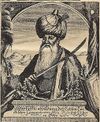
|
1676 | 1680 | بايلربك | [1][2][33] | ||
| 74 | عثمان باشا البوسني | الصورة غير متوافرة | 1680 | 1683 | بايلربك | [1][2][33] | ||
| 75 | حمزة باشا | الصورة غير متوافرة | 1683 | 1687 | بايلربك | [1][2][33] | ||
| 76 | كتخدا حسن باشا | الصورة غير متوافرة | 1687 | 1687 | بايلربك | [1][2][33][note 11] | Also called by the epithet Kethüda/Ketkhoda, but mostly just Hasan Pasha | |
| 77 | دماط حسن باشا (فترة 1) | الصورة غير متوافرة | 1687 | 1689 | بايلربك | [1][2][33] | ||
| 78 | سرخوش أحمد باشا | الصورة غير متوافرة | 1689 | 1691 | بايلربك | [1][2][33][note 12] | Died in office on March 13, 1961[1][33] | |
| 79 | علي مورلي خازندار باشا | الصورة غير متوافرة | 1691 | 1695 | بايلربك | [1][2][33][note 13] | Also known as Moralı Hazinedar Ali Pasha (epithets switched)[2] | |
| 80 | إسماعيل چلبي باشا | الصورة غير متوافرة | 1695 | 1697 | بايلربك | [1][2][33][84][85][note 14] | Deposed by the local soldiers[86] | |
| Kesici Hasan Pasha | الصورة غير متوافرة | 1697 | 1698 | قائمقام | [1][86][note 15] | Acting governor, installed by soldiers; served for 5 to 8 months[86] | ||
| 81 | حسين فيراري باشا | الصورة غير متوافرة | 1698 | 1699 | بايلربك | [1][2][33][note 16] | Also known by the epithets Boşnak (Bosniak), Sarı, Dizveren, and Muradi[2][87] | |
| 82 | محمد قرة باشا (فترة 1) | الصورة غير متوافرة | 1699 | 1704 | بايلربك | [1][2][33][88] | ||
| 83 | سليمان بلطشي باشا | الصورة غير متوافرة | 1704 | 1704 | بايلربك | [1][2][33] | Never took office[33] | |
| 84 | محمد رامي باشا | الصورة غير متوافرة | 1704 | 1706 | بايلربك | [1][2][33][89] | ||
| 85 | علي دلاقي باشا (فترة 1) | الصورة غير متوافرة | 1706 | 1707 | بايلربك | [1][2][note 17] | ||
| 86 | حسن دماط باشا (فترة 2) | الصورة غير متوافرة | 1707 | 1709 | بايلربك | [1][2][90] | ||
| 87 | ابراهيم مورالي باشا | الصورة غير متوافرة | 1709 | 1710 | بايلربك | [1][2][91] | Jailed and exiled by the sultan after dismissal[1] | |
| 88 | خليل قوس باشا | الصورة غير متوافرة | 1710 | 1711 | بايلربك | [1][2][91] | Overthrown by local beys[3][92] | |
| 89 | محمد والي باشا (فترة 1) | الصورة غير متوافرة | 1711 | 1712 | بايلربك | [1][2][92] | There was an insurrection begun by a Turkish religious fanatic, but it failed[93] | |
| 90 | محمد قرة باشا (فترة 2) | الصورة غير متوافرة | 1712 | 1712 | بايلربك | [1] | Held the office for a minuscule amount of time[1] | |
| 91 | محمد والي باشا (فترة 2) | الصورة غير متوافرة | 1712 | 1714 | بايلربك | [1][2][92] | ||
| 92 | عبدي باشا (1st) | الصورة غير متوافرة | 1714 | 1716 | بايلربك | [40][94][95][note 18] | Ended the remains of the insurrection begun in 1711 by the religious fanatic[96] | |
| 93 | علي دلاق باشا (فترة 2) | الصورة غير متوافرة | 1716 | 1720 | بايلربك | [1][2][note 17] | His rule was calm, but the sultan ordered his execution[1][97] | |
| 94 | رجب باشا | الصورة غير متوافرة | 1720 | 1721 | بايلربك | [1][2][97] | Dismissed after failing to assassinate ibn Iwaz on the sultan's orders[98] | |
| 95 | Nişancı Mehmed Pasha (tr) (فترة 1) | الصورة غير متوافرة | 1721 | 1725 | بايلربك | [1][2][note 19] | Deposed by the forces of Çerkes Mehmed Bey after displeasing him[99] | |
| 96 | علي مورلاي باشا | الصورة غير متوافرة | 1725 | 1726 | بايلربك | [1][2][100] | ||
| 97 | Nişancı Mehmed Pasha (tr) (فترة 2) | الصورة غير متوافرة | 1726 | 1727 | بايلربك | [1][2][note 19] | ||
| 98 | أبو بكر باشا (فترة 1) | الصورة غير متوافرة | 1727 | 1729 | بايلربك | [1][2][101] | ||
| 99 | عبدي باشا (فترة 2) | الصورة غير متوافرة | 1729 | 1729 | بايلربك | [40][94][95][note 18] | ||
| 100 | عبد الله قوپرولو باشا | الصورة غير متوافرة | 1729 | 1731 | بايلربك | [1][2][102][note 20] | ||
| 101 | Silahdar Damat Mehmed Pasha | الصورة غير متوافرة | 1731 | 1733 | بايلربك | [1][2][note 21] | ||
| 102 | عثمان محصل باشا | الصورة غير متوافرة | 1733 | 1735 | بايلربك | [1][2][103] | There was a man claiming to be a prophet, and widespread apocalyptic fears[103] | |
| 103 | أبو بكر باشا (فترة 2) | الصورة غير متوافرة | 1735 | 1739 | بايلربك | [1][2][101][note 22] | Deposed by local troops[104] | |
| 104 | سليمان باشا العظم | الصورة غير متوافرة | 1739 | 1740 | بايلربك | [1][104] | Deposed by local troops[105] | |
| 105 | علي حكيماوگلو باشا (فترة 1) | 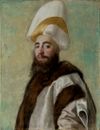
|
1740 | 1741 | بايلربك | [1][2][note 23] | His rule was peaceful and free of insurrections[105] | |
| 106 | خطيبزاد يحيى باشا | الصورة غير متوافرة | 1741 | 1743 | بايلربك | [1][2][105] | He was the son-in-law of predecessor Hekimoğlu Ali Pasha[1] | |
| 107 | محمد يدقشي باشا | الصورة غير متوافرة | 1743 | 1744 | بايلربك | [1][2][106][note 24] | Troops rioted, demanding pay and rations from the granary[106] | |
| 108 | محمد رجب خوجة باشا | الصورة غير متوافرة | 1744 | 1748 | بايلربك | [1][2][106][note 25] | He was a "profound scholar"; forced to step down by local troops[107] | |
| 109 | علي يكن باشا | الصورة غير متوافرة | 1748 | 1748 | بايلربك | [1][2] | Nephew of Yedekçi Mehmed Pasha; never took office, only appointed for a week[1][2] | |
| 110 | أحمد نشنجي باشا | الصورة غير متوافرة | 1748 | 1751 | بايلربك | [1][2][108][note 26] | Interested in the sciences, but found Egyptians to be largely uneducated[108][109] | |
| 111 | عبد الله سيد باشا | الصورة غير متوافرة | 1751 | 1753 | بايلربك | [1][2][110][note 27] | ||
| 112 | محمد أمين دويدار باشا | الصورة غير متوافرة | 1753 | 1753 | بايلربك | [1][2][110][note 28] | Died very soon after taking office[1][110] | |
| 113 | مصطفى بلطجيزاد باشا | الصورة غير متوافرة | 1752 | 1756 | بايلربك | [1][2][note 29] | ||
| 114 | علي حكيماوگلو باشا (2nd) | 
|
1756 | 1757 | بايلربك | [1][2][note 23] | His second term was again largely peaceful[111] | |
| 115 | سعد الدين باشا العظم | الصورة غير متوافرة | 1757 | 1757 | بايلربك | [1][2] | Nephew of Sulayman Pasha al-Azm[2] | |
| 116 | محمد سعيد يرميزكيزاد باشا | 
|
1757 | 1758 | بايلربك | [1][2][102][note 30] | ||
| 117 | Köse Bahir Mustafa Pasha (tr) (1st) | الصورة غير متوافرة | 1758 | 1761 | بايلربك | [1][2][112][113][note 31] | ||
| 118 | أحمد كامل باشا | الصورة غير متوافرة | 1761 | 1761 | بايلربك | [1][2][89][112] | Deposed in August 1761 by the local emirs[89][112] | |
| 119 | Köse Bahir Mustafa Pasha (tr) (فترة 2) | الصورة غير متوافرة | 1761 | 1762 | بايلربك | [89][112][note 31] | Reinstalled by the local emirs[89][112] | |
| 120 | راسم أبو بكر باشا | الصورة غير متوافرة | 1762 | 1762 | بايلربك | [1][2][89] | Died two months into term, buried in the City of the Dead necropolis in Cairo[89][112] | |
| 121 | Ahıskalı Mehmed Pasha | الصورة غير متوافرة | 1762 | 1764 | بايلربك | [1][2][note 32] | ||
| 122 | أحمد حقي باشا | الصورة غير متوافرة | 1764 | 1764 | بايلربك | [1][2][note 33] | Died soon after taking office in September 1764[1][2] | |
| 123 | حسن حقي مقار باشا | الصورة غير متوافرة | 1764 | 1765 | بايلربك | [1][2][112] | Dismissed soon after taking office[89][112] | |
| 124 | Silahdar Mahir Hamza Pasha (tr) | الصورة غير متوافرة | 1765 | 1767 | بايلربك | [2][89][note 34] | Deposed by the local emirs[89] | |
| 125 | محمد چلبي باشا | الصورة غير متوافرة | 1767 | 1767 | بايلربك | [1][2][89][note 35] | ||
| 126 | محمد رقيم باشا | الصورة غير متوافرة | 1767 | 1768 | بايلربك | [1][2][102][114][115][116] | Deposed by Ali Bey Al-Kabir after making a move against him[117] | |
| علي بك الكبير | 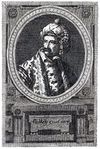
|
1768 | 1769 | قائمقام | [117][note 36] | Became acting governor after forcing out the last governor[117] | ||
| 127 | حافظ أحمد كوپرولو باشا | الصورة غير متوافرة | 1769 | 1769 | بايلربك | [1][2][note 37] | Died shortly after taking office[1][2] | |
| 128 | Kelleci Osman Pasha | الصورة غير متوافرة | 1769 | 1771 | بايلربك | [1][2][note 38] | After him, a kaymakam (acting governor) probably ruled for a year | |
| 129 | عثمان وكيل باشا | الصورة غير متوافرة | 1772 | 1773 | بايلربك | [1][2][note 39] | Died shortly after taking office[1][2] | |
| 130 | خليل قرة باشا | الصورة غير متوافرة | 1773 | 1774 | بايلربك | [1][2][118][note 40] | Had little power; actual power was held by Mamluk Muhammad Bey Abu'l-Dhahab[119] | |
| 131 | ابراهيم حقي باشا | الصورة غير متوافرة | 1774 | 1775 | بايلربك | [1][2][note 41] | ||
| 132 | محمد عزت باشا | الصورة غير متوافرة | 1775 | 1778 | بايلربك | [1][2][120][note 42] | Deposed by local emirs Mamluk on July 15, 1778[121] | |
| 133 | إسماعيل رئيف باشا (فترة 1) | الصورة غير متوافرة | 1779 | 1779 | بايلربك | [1][122][note 43] | He was replaced by the sultan in late September 1779 with Ibrahim Pasha[123] | |
| 134 | ابراهيم باشا | الصورة غير متوافرة | 1779 | 1779 | بايلربك | [124][note 44] | He died in office in November 1779 (one month after his arrival)[125] | |
| 135 | إسماعيل رئيف باشا (فترة 2) | الصورة غير متوافرة | 1779 | 1780 | بايلربك | [1][125][note 43] | Reappointed November 1779, but deposed by local Mamluk emirs in July 1780[125] | |
| ابراهيم بك (فترة 1) | الصورة غير متوافرة | 1780 | 1781 | قائمقام | [125] | The sultan gave office back to Raif Ismail Pasha, but Ibrahim Bey didn't comply[126] | ||
| 136 | Melek Mehmed Pasha (tr) | الصورة غير متوافرة | 1781 | 1782 | بايلربك | [1][127][note 45] | His rule was peaceful and he was well-liked by the emirs[128] | |
| 137 | الاسم غير معروف | الصورة غير متوافرة | 1782 | 1783 | بايلربك | [129][note 46] | His identity is unknown, perhaps partially named "Sharif/Şerif Pasha" | |
| 138 | Silahdar Mehmed Pasha (tr) | الصورة غير متوافرة | 1783 | 1784 | بايلربك | [1][2][note 47] | Deposed by the Mamluk bey Murad Bey on October 30, 1784[130] | |
| مراد بك | 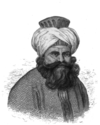
|
1784 | 1785 | قائمقام | [130] | He deposed his predecessor, but he was already the de facto ruler of Egypt[130] | ||
| ابراهيم بك (فترة 2) | الصورة غير متوافرة | 1784 | 1785 | قائمقام | [131] | The incoming governor made him acting governor on February 20, 1785[131] | ||
| 139 | Yeğen Seyyid Mehmed Pasha (tr) | الصورة غير متوافرة | 1785 | 1786 | بايلربك | [1][2][132][note 48] | Cezayirli Gazi Hasan Pasha expelled the Mamluk emirs (Murad and Ibrahim)[1][133] | |
| Cezayirli Gazi Hasan Pasha | الصورة غير متوافرة | 1786 | 1787 | أميرال | [134] | De facto ruler when Keki Abdi Pasha refused the office until emirs were defeated[134] | ||
| 140 | Keki Abdi Pasha (1st) | الصورة غير متوافرة | 1787 | 1788 | بايلربك | [1][2][134] | Appointed on 24 October 1786, but left governance to Hasan Pasha for a while[134] | |
| 141 | إسماعيل باشا الطرابلسي (فترة 1) | الصورة غير متوافرة | 1788 | 1789 | بايلربك | [1][135][note 49] | The sultan reinstated Keki Abdi Pasha upon his request on 3 January 1789[136] | |
| 142 | Keki Abdi Pasha (2nd) | الصورة غير متوافرة | 1789 | 1789 | بايلربك | [136] | Cezayirli Gazi Hasan Pasha, Ismail Pasha's mentor, asked sultan to reinstate him[136] | |
| 143 | إسماعيل باشا الطرابلسي (فترة 2) | الصورة غير متوافرة | 1789 | 1791 | بايلربك | [136][note 49] | Dismissed and appointed governor of Morea Eyalet[137] | |
| 144 | عزت محمد صفرانبولولو باشا | الصورة غير متوافرة | 1791 | 1794 | بايلربك | [1][2][138][139][note 50] | Murad Bey and Ibrahim Bey, previously exiled in 1786, returned to de facto power[140] | |
| 145 | حقي صالح قيصرلي باشا | الصورة غير متوافرة | 1794 | 1796 | بايلربك | [1][2][139] | Mamluk emirs Murad Bey and Ibrahim Bey continued to wield de facto power[139] | |
| The French occupy Egypt in 1798, with Napoleon Bonaparte (1798–99), Jean Baptiste Kléber (1799–1800), and Jacques-François Menou (1800–01) holding de facto governing power. | ||||||||
| 146 | حقي أبو بكر لقماچي باشا | الصورة غير متوافرة | 1796 | 1798 | بايلربك | [1][2][141][note 51] | French troops under Napoleon landed at Alexandria and later reached Cairo[141] | |
| 147 | عبد الله باشا العظم | الصورة غير متوافرة | 1798 | 1799 | بايلربك | [1][2][142][note 52] | Napoleon had him confirmed governor as a sign of Ottoman consent to his rule[142] | |
| 147 | نصوح باشا العظم | 1800 | 1801 | بايلربك | [1][2][143][note 53] | The French left Cairo (and eventually Egypt altogether) | ||
| The French occupation ends in 1801, succumbing to a combined British and Ottoman attack. | ||||||||
| 148 | مراق محمد إبو باشا | الصورة غير متوافرة | 1801 | 1801 | بايلربك | [1][2][144][145][146][note 54] | Dismissed 21 September 1801, he left for his estate on 8 January 1802[145][146] | |
| 149 | Koca Hüsrev Mehmed Pasha (فترة 1) | الصورة غير متوافرة | 1802 | 1803 | بايلربك | [1][2][145][147][note 55] | Arrived 22 January 1802;[147] he was instructed to kill or imprison Mamluk emirs | |
| طاهر باشا | الصورة غير متوافرة | 1803 | 1803 | قائمقام | [148][note 56] | Grabbed power; head of Albanian troops; assassinated by Janissaries in 26 days[149] | ||
| Albanian troops led by Muhammad Ali of Egypt, originally sent in 1801 by the Ottoman sultan to fight the French, grab de facto control of Egypt from the Ottomans. | ||||||||
| 150 | أحمد مفتيزاد باشا | الصورة غير متوافرة | 1803 | 1803 | حاكم | [1][150][151][note 57] | Took power in June against the Albanians, although they had de facto control[151] | |
| ابراهيم بك (فترة 2، في نفس الوقت) | الصورة غير متوافرة | 1803 | 1804 | قائمقام | [152][153] | Made governor by Muhammad Ali of Egypt in June, who governed through him[152] | ||
| 151 | علي طرابلوسلو باشا (في نفس الوقت) | الصورة غير متوافرة | 1803 | 1804 | بايلربك | [1][2][154] | Sent by the Ottomans in July to take back Egypt from the Albanians, but killed[154] | |
| 152 | Koca Hüsrev Mehmed Pasha (فترة ثانية) | الصورة غير متوافرة | 1804 | 1804 | بايلربك | [155][note 58] | He was a puppet governor for 2 days under Muhammad Ali of Egypt[155] | |
| 153 | أحمد خورشيد باشا | 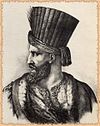
|
1804 | 1805 | بايلربك | [1][2][156][157] | Allowed by Muhammad Ali of Egypt to govern, but forced to step down in favor of him | |
| 154 | محمد علي باشا | 
|
1805 | محمد علي، قائد ألبانين عين رسمياً حاكم على مصر عام 1805، أسس اسرة محمد علي؛ انظر قائمة حكام أسرة محمد علي "للحكام" الاسميين بعد 1805. | ||||
. . . . . . . . . . . . . . . . . . . . . . . . . . . . . . . . . . . . . . . . . . . . . . . . . . . . . . . . . . . . . . . . . . . . . . . . . . . . . . . . . . . . . . . . . . . . . . . . . . . . . . . . . . . . . . . . . . . . . . . . . . . . . . . . . . . . . . . . . . . . . . . . . . . . . . . . . . . . . . . . . . . . . . . .
انظر أيضاً
هوامش
- ^ أ ب ت ث ج ح خ د ذ ر ز س ش ص ض ط ظ ع غ ف ق ك ل م ن هـ و ي أأ أب أت أث أج أح أخ أد أذ أر أز أس أش أص أض أط أظ أع أغ أف أق أك أل أم أن أهـ أو أي بأ بب بت بث بج بح بخ بد بذ بر بز بس بش بص بض بط بظ بع بغ بف بق بك بل بم بن به بو بي تأ تب تت تث تج تح تخ تد تذ تر تز تس تش تص تض تط تظ تع تغ تف تق تك تل تم تن ته تو تي ثأ ثب ثت ثث ثج ثح ثخ ثد ثذ ثر ثز ثس ثش ثص ثض ثط ثظ ثع ثغ ثف ثق ثك ثل ثم ثن ثه ثو ثي جأ جب جت جث جج جح جخ جد جذ جر جز جس جش جص جض جط جظ جع جغ جف Mehmet Süreyya (1996) [1890] (in Turkish), Sicill-i Osmanî, Beşiktaş, Istanbul: Türkiye Kültür Bakanlığı and Türkiye Ekonomik ve Toplumsal Tarih Vakfı, http://books.google.com/books?id=btElAQAAMAAJ
- ^ أ ب ت ث ج ح خ د ذ ر ز س ش ص ض ط ظ ع غ ف ق ك ل م ن هـ و ي أأ أب أت أث أج أح أخ أد أذ أر أز أس أش أص أض أط أظ أع أغ أف أق أك أل أم أن أهـ أو أي بأ بب بت بث بج بح بخ بد بذ بر بز بس بش بص بض بط بظ بع بغ بف بق بك بل بم بن به بو بي تأ تب تت تث تج تح تخ تد تذ تر تز تس تش تص تض تط تظ تع تغ تف تق تك تل تم تن ته تو تي ثأ ثب ثت ثث ثج ثح ثخ ثد ثذ ثر ثز ثس ثش ثص ثض ثط ثظ ثع ثغ ثف ثق ثك ثل ثم ثن ثه ثو ثي جأ Yılmaz Öztuna (1994). Büyük Osmanlı Tarihi: Osmanlı Devleti'nin siyasî, medenî, kültür, teşkilât ve san'at tarihi (in Turkish). Vol. 10. Ötüken Neşriyat A.S. pp. 412–416. ISBN 975-437-141-5.
{{cite book}}: CS1 maint: unrecognized language (link) - ^ أ ب ت ث ج ح خ د ذ ر ز س ش ص ض ط ظ ع غ ف ق ك Holt, P. M.; Gray, Richard (1975). Fage, J.D.; Oliver, Roland (eds.). "Egypt, the Funj and Darfur". The Cambridge History of Africa. London, New York, Melbourne: Cambridge University Press. IV: 14–57. doi:10.1017/CHOL9780521204132.003.
- ^ Behrens-abouseif, Doris; Crecelius, Daniel (1995), "Egypt's Adjustment to Ottoman Rule: Institutions, Waqf & Architecture in Cairo (16th & 17th Centuries), (Islamic History & Civilization, Volume 7)", Middle East Studies Association Bulletin 29 (1): 90–91
- ^ Türk Tarih Kurumu (1996). Belleten. p. 112.
- ^ Evli̇ya Çelebi̇ (1988). Evliya Çelebi's Book of Travels: Evliya Çelebi in Diyarbekir. Brill Archive. p. 61. ISBN 978-90-04-08165-9.
- ^ أ ب ت Kaya Şahin (29 March 2013). Empire and Power in the Reign of Süleyman: Narrating the Sixteenth-Century Ottoman World. Cambridge University Press. pp. 53–54. ISBN 978-1-107-03442-6.
- ^ Gülru Neci̇poğlu; Julia Bailey (2008). Frontiers of Islamic Art and Architecture: Essays in Celebration of Oleg Grabar's Eightieth Birthday ; the Aga Khan Program for Islamic Architecture Thirtieth Anniversary Special Volume. BRILL. p. 98. ISBN 978-90-04-17327-9.
- ^ أ ب Raymond, André (2001). Cairo: City of History. Translated by Willard Wood (Harvard ed.). Cairo, Egypt; New York, New York: American University in Cairo Press. p. 191. ISBN 978-977-424-660-9.
- ^ أ ب ت ث ج Giancarlo Casale (26 January 2010). The Ottoman Age of Exploration. Oxford University Press. pp. 87, 102. ISBN 978-0-19-979879-7.
- ^ أ ب Hamilton Alexander Rosskeen Gibb; Charles Pellat; Joseph Schacht (1992). The Encyclopaedia of Islam. Brill. p. 721.
- ^ أ ب Giancarlo Casale (26 January 2010). The Ottoman Age of Exploration. Oxford University Press. p. 102. ISBN 978-0-19-979879-7.
- ^ أ ب ت ث ج Michael Winter (14 January 2004). Egyptian Society Under Ottoman Rule, 1517-1798. Taylor & Francis. p. 35. ISBN 978-0-203-16923-0.
- ^ أ ب Michael Winter (1 March 2006). Society And Religion in Early Ottoman Egypt: Studies in the Writing of 'Abd Al-Wahhab Al-Sha'Rani. Transaction Publishers. pp. 42–53. ISBN 978-1-4128-3458-2.
- ^ de Groot, Alexander H.; Winkelhane, Gerd; Schwarz, Klaus (1989). "Der osmanische Statthalter Iskender Pascha (gest. 1571) und seine Stiftungen in Agypten und am Bosporus". Die Welt des Islams. 29 (1/4): 215. doi:10.2307/1571021. ISSN 0043-2539.
- ^ Raymond, André (2001). Cairo: City of History. Translated by Willard Wood (Harvard ed.). Cairo, Egypt; New York, New York: American University in Cairo Press. p. 235. ISBN 978-977-424-660-9.
- ^ أ ب Giancarlo Casale (26 January 2010). The Ottoman Age of Exploration. Oxford University Press. p. 110. ISBN 978-0-19-979879-7.
- ^ Islamic Studies. Islamic Research Institute. 2002. p. 328.
- ^ Die Welt des Islams. Brill. 1979. pp. 130, 131, 144.
- ^ أ ب Jane Hathaway (2003). A Tale of Two Factions: Myth, Memory, and Identity in Ottoman Egypt and Yemen. SUNY Press. p. 219. ISBN 978-0-7914-8610-8.
- ^ أ ب ت Yılmaz Öztuna (1979). Başlangıcından zamanımıza kadar büyük Türkiye tarihi: Türkiye'nin siyasî, medenî, kültür, teşkilât ve san'at tarihi. Ötüken Yayınevi. p. 51.
- ^ Türklük araştırmaları dergisi. Fakülte. 2008. p. 282.
- ^ Reşid İskenderoğlu (1989). Beğlerbeği Gazi İskender Paşa, 1492-1571. R. İskenderoğlu. pp. 41, 56.
- ^ أ ب ت ث ج Michael Winter (14 January 2004). Egyptian Society Under Ottoman Rule, 1517-1798. Taylor & Francis. p. 34. ISBN 978-0-203-16923-0.
- ^ أ ب ت ث Accounts and Extracts of the Manuscripts in the Library of the King of France. Vol. 2. R. Faulder. 1789. p. 18.
- ^ Philip Sidney (2012). The Correspondence of Sir Philip Sidney. Oxford University Press. p. 359. ISBN 978-0-19-955822-3.
- ^ Muhedin Fijuljanin (2010). Sandžački Bošnjaci: monografija. Centar za Bošnjačke Studije. ISBN 978-86-85599-14-9.
- ^ أ ب ت Uzunçarsılı, İsmail Hakkı, (1954) Osmanlı Tarihi III. Cilt, 2. Kısım , XVİ. Yüzyıl Ortalarından XVII. Yüzyıl Sonuna kadar, Ankara: Türk Tarih Kurumu (Altıncı Baskı 2011 ISBN 978-975-16-0014-1 ) p. 357–358 خطأ استشهاد: وسم
<ref>غير صالح؛ الاسم "uzuncarsili-1" معرف أكثر من مرة بمحتويات مختلفة. - ^ أ ب Doris Behrens-Abouseif (1994). Egypt's Adjustment to Ottoman Rule: Institutions, Waqf and Architecture in Cairo, 16th and 17th Centuries. Brill Academic Pub. ISBN 978-90-04-09927-2.
- ^ Michael Winter (14 January 2004). Egyptian Society Under Ottoman Rule, 1517-1798. Taylor & Francis. pp. 34, 45, 96, 208. ISBN 978-0-203-16923-0.
- ^ أ ب Emine Fetvaci (25 January 2013). Picturing History at the Ottoman Court. Indiana University Press. p. 52. ISBN 978-0-253-00678-3.
- ^ İsmail Hakkı Uzunçarşılı (1945). Osmanli devletinin saray teşkilâti. Türk Tarih Kurumu Basımevi. p. 390.
- ^ أ ب ت ث ج ح خ د ذ ر ز س ش ص ض ط ظ ع غ ف ق ك ل م ن هـ و ي أأ أب أت أث أج أح أخ أد أذ أر أز أس أش أص أض أط أظ أع أغ أف أق أك أل أم أن أهـ أو أي بأ بب بت Holt, P. M. (2009). "The beylicate in Ottoman Egypt during the seventeenth century". Bulletin of the School of Oriental and African Studies. 24 (02): 227–229. doi:10.1017/S0041977X00091424. ISSN 0041-977X.
- ^ Muhammed es-Seyyid Mahmud (1990). 16. asırda Mısır Eyâleti. Edebiyat Fakültesi Basımevi. pp. 99, 125, 151. ISBN 978-975-400-030-6.
- ^ أ ب Uzunçarsılı, İsmail Hakkı, (1954) Osmanlı Tarihi III. Cilt, 2. Kısım , XVİ. Yüzyıl Ortalarından XVII. Yüzyıl Sonuna kadar, Ankara: Türk Tarih Kurumu (Altıncı Baskı 2011 ISBN 978-975-16-0014-1 ) say.360 خطأ استشهاد: وسم
<ref>غير صالح؛ الاسم "uzuncarsili" معرف أكثر من مرة بمحتويات مختلفة. - ^ أ ب Nelly Hanna (1998). Making Big Money in 1600: The Life and Times of Isma'il Abu Taqiyya, Egyptian Merchant. Syracuse University Press. p. 101. ISBN 978-0-8156-2763-0.
- ^ Michael Winter (14 January 2004). Egyptian Society Under Ottoman Rule, 1517-1798. Taylor & Francis. pp. 35, 45, 96. ISBN 978-0-203-16923-0.
- ^ Peter Malcolm Holt (1966), Egypt and the Fertile Crescent 1516-1922: A Political History (2nd ed.), Ithaca, New York: Cornell University Press, http://books.google.com/books?id=MEUNRAAACAAJ
- ^ Michael Winter (14 January 2004). Egyptian Society Under Ottoman Rule, 1517-1798. Taylor & Francis. pp. 45, 96. ISBN 978-0-203-16923-0.
- ^ أ ب ت M. W. Daly; Carl F. Petry (10 December 1998). The Cambridge History of Egypt. Vol. 2. Cambridge University Press. p. 40. ISBN 978-0-521-47211-1. خطأ استشهاد: وسم
<ref>غير صالح؛ الاسم "DalyPetry1998-154" معرف أكثر من مرة بمحتويات مختلفة. خطأ استشهاد: وسم<ref>غير صالح؛ الاسم "DalyPetry1998-154" معرف أكثر من مرة بمحتويات مختلفة. - ^ أ ب ت Michael A. Cook; Michael Bonner; Behnam Sadeghi (21 March 2011). The Islamic Scholarly Tradition: Studies in History, Law, and Thought in Honor of Professor Michael Allan Cook. BRILL. p. 154. ISBN 978-90-04-19435-9. خطأ استشهاد: وسم
<ref>غير صالح؛ الاسم "CookAhmed2011" معرف أكثر من مرة بمحتويات مختلفة. - ^ أ ب Mehmet Süreyya Bey; Ali Aktan (1996). Tezkire-i meşâhir-i Osmaniyye. Sebil Yayınevi. p. 122.
- ^ أ ب Türkiye Diyanet Vakfı İslâm ansiklopedisi. Türkiye Diyanet Vakfı, İslâm Ansiklopedisi Genel Müdürlüğü. 2004. p. 564. ISBN 978-975-389-415-9.
- ^ أ ب M. W. Daly; Carl F. Petry (10 December 1998). The Cambridge History of Egypt. Vol. 2. Cambridge University Press. p. 18. ISBN 978-0-521-47211-1.
- ^ أ ب Jane Hathaway; Karl K. Barbir (2008). The Arab lands under Ottoman rule, 1516-1800. Pearson Longman. pp. 63, 255. ISBN 978-0-582-41899-8.
- ^ أ ب A. Zuhuri Danışman (1965). Osmanlı İmparatorluğu tarihi. Z. Danışman Yayınevi. p. 243.
- ^ أ ب Michael Winter (14 January 2004). Egyptian Society Under Ottoman Rule, 1517-1798. Taylor & Francis. p. 47. ISBN 978-0-203-16923-0.
- ^ أ ب ت ث ج ح خ Accounts and Extracts of the Manuscripts in the Library of the King of France. Vol. 2. R. Faulder. 1789. p. 41. خطأ استشهاد: وسم
<ref>غير صالح؛ الاسم "France1796-4" معرف أكثر من مرة بمحتويات مختلفة. - ^ أ ب ت Accounts and Extracts of the Manuscripts in the Library of the King of France. Vol. 2. R. Faulder. 1789. p. 42.
- ^ Accounts and Extracts of the Manuscripts in the Library of the King of France. Vol. 2. R. Faulder. 1789. p. 43.
- ^ Accounts and Extracts of the Manuscripts in the Library of the King of France. Vol. 2. R. Faulder. 1789. p. 44.
- ^ Erhan Afyoncu; Ahmet Önal; Uğur Demir (2010). Osmanlı İmparatorluğu'nda askeri isyanlar ve darbeler. Yeditepe Yayınevi. p. 81. ISBN 978-605-4052-20-2.
- ^ Accounts and Extracts of the Manuscripts in the Library of the King of France. Vol. 2. R. Faulder. 1789. p. 46.
- ^ أ ب ت ث Accounts and Extracts of the Manuscripts in the Library of the King of France. Vol. 2. R. Faulder. 1789. p. 48.
- ^ أ ب مركز الأبحاث للتاريخ والفنون والثقافة الإسلامية بإستنبول; مجلس الأعلى للثقافة (مصر) (2010). Proceedings of the International Conference on Egypt during the Ottoman Era, 26-30 November 2007, Cairo. Research Centre for Islamic History, Art, and Culture. p. 22. ISBN 978-92-9063-198-9.
- ^ أ ب Accounts and Extracts of the Manuscripts in the Library of the King of France. Vol. 2. R. Faulder. 1789. p. 66.
- ^ Murphey, Rhoads (1998) Ottoman Warfare, 1500-1700 UCL Press, London page 228, note 69, ISBN 1-85728-389-9, citing von Zambaur, Eduard Karl Max (1927) Manuel de généalogie et de chronologie pour l'histoire de l'Islam Lafaire, Hanover, OCLC 61984974, page 252
- ^ Accounts and Extracts of the Manuscripts in the Library of the King of France. Vol. 2. R. Faulder. 1789. pp. 69–70.
- ^ Accounts and Extracts of the Manuscripts in the Library of the King of France. Vol. 2. R. Faulder. 1789. p. 70.
- ^ Hugh Chisholm (1910). The Encyclopædia britannica: a dictionary of arts, sciences, literature and general information. The Encyclopædia Britannica Company. p. 103.
- ^ Accounts and Extracts of the Manuscripts in the Library of the King of France. Vol. 2. R. Faulder. 1789. p. 74.
- ^ أ ب d'Avennes, Prisse (1983) Arab art as seen through the monuments of Cairo from the 7th century to the 18th (translated from French by J.I. Erythrospis) Le Sycomore, Paris, page 61, ISBN 0-86356-000-8
- ^ The Numismatic Circular. Vol. 86. 1978. p. 239.
- ^ Accounts and Extracts of the Manuscripts in the Library of the King of France. Vol. 2. R. Faulder. 1789. p. 83.
- ^ Accounts and Extracts of the Manuscripts in the Library of the King of France. Vol. 2. R. Faulder. 1789. p. 84.
- ^ أ ب ت Holt, P. M. (2009). "The Exalted Lineage of Ridwān Bey: Some Observations on a Seventeenth-Century Mamluk Genealogy". Bulletin of the School of Oriental and African Studies. 22 (02): 221. doi:10.1017/S0041977X00068671. ISSN 0041-977X.
- ^ Accounts and Extracts of the Manuscripts in the Library of the King of France. Vol. 2. R. Faulder. 1789. p. 88.
- ^ Accounts and Extracts of the Manuscripts in the Library of the King of France. Vol. 2. R. Faulder. 1789. p. 91.
- ^ Accounts and Extracts of the Manuscripts in the Library of the King of France. Vol. 2. R. Faulder. 1789. pp. 94–102.
- ^ Accounts and Extracts of the Manuscripts in the Library of the King of France. Vol. 2. R. Faulder. 1789. pp. 101–102.
- ^ أ ب Accounts and Extracts of the Manuscripts in the Library of the King of France. Vol. 2. R. Faulder. 1789. p. 102.
- ^ أ ب ت ث Accounts and Extracts of the Manuscripts in the Library of the King of France. Vol. 2. R. Faulder. 1789. p. 103.
- ^ Accounts and Extracts of the Manuscripts in the Library of the King of France. Vol. 2. R. Faulder. 1789. pp. 108–109.
- ^ Uzunçarsılı, İsmail Hakkı, (1954) Osmanlı Tarihi III. Cilt, 2. Kısım , XVI. Yüzyıl Ortalarından XVII. Yüzyıl Sonuna kadar), Ankara: Türk Tarih Kurumu (Altıncı Baskı 2011 ISBN 978-975-16-0014-1 ) say.404
- ^ أ ب Accounts and Extracts of the Manuscripts in the Library of the King of France. Vol. 2. R. Faulder. 1789. p. 109.
- ^ أ ب Accounts and Extracts of the Manuscripts in the Library of the King of France. Vol. 2. R. Faulder. 1789. p. 111.
- ^ ثريا، محمد; Ali Aktan (1998). Sicill-i Osmanî, yahud, Tezkire-i meşâhir-i Osmâniyye. Sebil Yayınevi. p. 354.
- ^ ʻĪsā-zāde (1996). ʻÎsâ-zâde târı̂hi: metin ve tahlı̂l. İstanbul Fetih Cemiyeti. pp. 43, 68.
- ^ Server Rifat İskit (1960). Resemli-haritalı mufassal Osmanlı tarihi. İskit Yayını. pp. 2041, 2066, 2070.
- ^ Mustafa Naima (1969). Naîmâ târihi. Z. Danışman Yayınevi. p. 2356.
- ^ Mehmet Süreyya Bey (1996). Sicill-i Osmanî. 6. Kültür Bakanlığı ile Türkiye Ekonomik ve Toplumsal Tarih Vakfı'nın ortak yayınıdır. p. 1687. ISBN 978-975-333-044-2.
- ^ أ ب Türk dünyası araştırmaları. Türk Dünyası Araştırmaları Vakfı. 2005. p. 196.
- ^ "Ahmed Paşa (Cebeci) Kimdir, Kısaca Hayatı, Eserleri, Hakkında Bilgi." Filozof.net. N.p., n.d. Web. 18 Oct. 2013. <http://filozof.net/Turkce/tarihi-sahsiyetler-kisilikler/20074-ahmed-pasa-cebeci-kimdir-kisaca-hayati-eserleri-hakkinda-bilgi.html>.
- ^ Behrens-Abouseif, Doris. Egypt's Adjustment to Ottoman Rule: Institutions, Waqf and Architecture in Cairo, 16th and 17th Centuries (Leiden: E.J. Brill, 1994), 65–6
- ^ Ahmad D. Damurdashi; ʻAbd al-Wahhāb Bakr Muḥammad (1991). Al-Damurdashi's Chronicle of Egypt, 1688-1755: Al-Durra Al-muṣāna Fī Akhbār Al-Kināna. BRILL. p. 57. ISBN 978-90-04-09408-6.
- ^ أ ب ت Ahmad D. Damurdashi; ʻAbd al-Wahhāb Bakr Muḥammad (1991). Al-Damurdashi's Chronicle of Egypt, 1688-1755: Al-Durra Al-muṣāna Fī Akhbār Al-Kināna. BRILL. p. 74. ISBN 978-90-04-09408-6.
- ^ Ahmad D. Damurdashi; ʻAbd al-Wahhāb Bakr Muḥammad (1991). Al-Damurdashi's Chronicle of Egypt, 1688-1755: Al-Durra Al-muṣāna Fī Akhbār Al-Kināna. BRILL. p. 79. ISBN 978-90-04-09408-6.
- ^ Ahmad D. Damurdashi; ʻAbd al-Wahhāb Bakr Muḥammad (1991). Al-Damurdashi's Chronicle of Egypt, 1688-1755: Al-Durra Al-muṣāna Fī Akhbār Al-Kināna. BRILL. p. 104. ISBN 978-90-04-09408-6.
- ^ أ ب ت ث ج ح خ د ذ ر ز Raymond, André (2001). Cairo: City of History. Translated by Willard Wood (Harvard ed.). Cairo, Egypt; New York, New York: American University in Cairo Press. p. 192. ISBN 978-977-424-660-9.
- ^ Ahmad D. Damurdashi; ʻAbd al-Wahhāb Bakr Muḥammad (1991). Al-Damurdashi's Chronicle of Egypt, 1688-1755: Al-Durra Al-muṣāna Fī Akhbār Al-Kināna. BRILL. p. 135. ISBN 978-90-04-09408-6.
- ^ أ ب 'Abd al-Rahman Jabarti; Thomas Philipp; Moshe Perlmann (1994). Abd Al-Rahmann Al-Jabarti's History of Egypt. Vol. 1. Franz Steiner Verlag Stuttgart. p. 62.
- ^ أ ب ت 'Abd al-Rahman Jabarti; Thomas Philipp; Moshe Perlmann (1994). Abd Al-Rahmann Al-Jabarti's History of Egypt. Vol. 1. Franz Steiner Verlag Stuttgart. p. 77.
- ^ 'Abd al-Rahman Jabarti; Thomas Philipp; Moshe Perlmann (1994). Abd Al-Rahmann Al-Jabarti's History of Egypt. Vol. 1. Franz Steiner Verlag Stuttgart. p. 79.
- ^ أ ب Jane Hathaway (2003). A Tale of Two Factions: Myth, Memory, and Identity in Ottoman Egypt and Yemen. SUNY Press. p. 135. ISBN 978-0-7914-8610-8.
- ^ أ ب 'Abd al-Rahman Jabarti; Thomas Philipp; Moshe Perlmann (1994). Abd Al-Rahmann Al-Jabarti's History of Egypt. Vol. 1. Franz Steiner Verlag Stuttgart. p. 86.
- ^ Hans Ferdinand Helmolt (1903). The World's History: Western Asia. Africa. W. Heinemann. p. 712.
- ^ أ ب 'Abd al-Rahman Jabarti; Thomas Philipp; Moshe Perlmann (1994). Abd Al-Rahmann Al-Jabarti's History of Egypt. Vol. 1. Franz Steiner Verlag Stuttgart. p. 90.
- ^ 'Abd al-Rahman Jabarti; Thomas Philipp; Moshe Perlmann (1994). Abd Al-Rahmann Al-Jabarti's History of Egypt. Vol. 1. Franz Steiner Verlag Stuttgart. p. 91.
- ^ 'Abd al-Rahman Jabarti; Thomas Philipp; Moshe Perlmann (1994). Abd Al-Rahmann Al-Jabarti's History of Egypt. Vol. 1. Franz Steiner Verlag Stuttgart. pp. 93–94.
- ^ 'Abd al-Rahman Jabarti; Thomas Philipp; Moshe Perlmann (1994). Abd Al-Rahmann Al-Jabarti's History of Egypt. Vol. 1. Franz Steiner Verlag Stuttgart. pp. 99–101.
- ^ أ ب 'Abd al-Rahman Jabarti; Thomas Philipp; Moshe Perlmann (1994). Abd Al-Rahmann Al-Jabarti's History of Egypt. Vol. 1. Franz Steiner Verlag Stuttgart. p. 241.
- ^ أ ب ت Istituto italiano di numismatica (1981). Annali Istituto italiano di numismatica. p. 124.
- ^ أ ب 'Abd al-Rahman Jabarti; Thomas Philipp; Moshe Perlmann (1994). Abd Al-Rahmann Al-Jabarti's History of Egypt. Vol. 1. Franz Steiner Verlag Stuttgart. pp. 238–241.
- ^ أ ب 'Abd al-Rahman Jabarti; Thomas Philipp; Moshe Perlmann (1994). Abd Al-Rahmann Al-Jabarti's History of Egypt. Vol. 1. Franz Steiner Verlag Stuttgart. p. 246.
- ^ أ ب ت 'Abd al-Rahman Jabarti; Thomas Philipp; Moshe Perlmann (1994). Abd Al-Rahmann Al-Jabarti's History of Egypt. Vol. 1. Franz Steiner Verlag Stuttgart. p. 247.
- ^ أ ب ت 'Abd al-Rahman Jabarti; Thomas Philipp; Moshe Perlmann (1994). Abd Al-Rahmann Al-Jabarti's History of Egypt. Vol. 1. Franz Steiner Verlag Stuttgart. p. 248.
- ^ 'Abd al-Rahman Jabarti; Thomas Philipp; Moshe Perlmann (1994). Abd Al-Rahmann Al-Jabarti's History of Egypt. Vol. 1. Franz Steiner Verlag Stuttgart. pp. 250–251.
- ^ أ ب Crecelius, Daniel (1990). Eighteenth Century Egypt: The Arabic Manuscript Sources. Claremont, California: Regina Books. ISBN 978-0-941690-42-3.
- ^ 'Abd al-Rahman Jabarti; Thomas Philipp; Moshe Perlmann (1994). Abd Al-Rahmann Al-Jabarti's History of Egypt. Vol. 1. Franz Steiner Verlag Stuttgart. p. 305.
- ^ أ ب ت 'Abd al-Rahman Jabarti; Thomas Philipp; Moshe Perlmann (1994). Abd Al-Rahmann Al-Jabarti's History of Egypt. Vol. 1. Franz Steiner Verlag Stuttgart. p. 307.
- ^ 'Abd al-Rahman Jabarti; Thomas Philipp; Moshe Perlmann (1994). Abd Al-Rahmann Al-Jabarti's History of Egypt. Vol. 1. Franz Steiner Verlag Stuttgart. p. 308.
- ^ أ ب ت ث ج ح خ د 'Abd al-Rahman Jabarti; Thomas Philipp; Moshe Perlmann (1994). Abd Al-Rahmann Al-Jabarti's History of Egypt. Vol. 1. Franz Steiner Verlag Stuttgart. p. 416.
- ^ Danişmend, İsmail Hâmi, (1961) Osmanlı Devlet Erkânı, İstanbul:Türkiye Yayınevi.
- ^ History today. History Today. 1959. p. 54.
- ^ The Numismatic Circular. 1975. p. 199.
- ^ Daniel Crecelius (1981). The Roots of Modern Egypt: A Study of the Regimes of 'Ali Bey Al-Kabir and Muhammad Bey Abu Al-Dhahab, 1760-1775. Bibliotheca Islamica. p. 58. ISBN 978-0-88297-029-5.
- ^ أ ب ت 'Abd al-Rahman Jabarti; Thomas Philipp; Moshe Perlmann (1994). Abd Al-Rahmann Al-Jabarti's History of Egypt. Vol. 1. Franz Steiner Verlag Stuttgart. p. 513.
- ^ 'Abd al-Rahman Jabarti; Thomas Philipp; Moshe Perlmann (1994). Abd Al-Rahmann Al-Jabarti's History of Egypt. Vol. 1. Franz Steiner Verlag Stuttgart. p. 631.
- ^ 'Abd al-Rahman Jabarti; Thomas Philipp; Moshe Perlmann (1994). Abd Al-Rahmann Al-Jabarti's History of Egypt. Vol. 1. Franz Steiner Verlag Stuttgart. p. 644.
- ^ 'Abd al-Rahman Jabarti; Thomas Philipp; Moshe Perlmann (1994). Abd Al-Rahmann Al-Jabarti's History of Egypt. Vol. 2. Franz Steiner Verlag Stuttgart. p. 1.
- ^ 'Abd al-Rahman Jabarti; Thomas Philipp; Moshe Perlmann (1994). Abd Al-Rahmann Al-Jabarti's History of Egypt. Vol. 2. Franz Steiner Verlag Stuttgart. p. 36.
- ^ 'Abd al-Rahman Jabarti; Thomas Philipp; Moshe Perlmann (1994). Abd Al-Rahmann Al-Jabarti's History of Egypt. Vol. 2. Franz Steiner Verlag Stuttgart. pp. 80–81.
- ^ 'Abd al-Rahman Jabarti; Thomas Philipp; Moshe Perlmann (1994). Abd Al-Rahmann Al-Jabarti's History of Egypt. Vol. 2. Franz Steiner Verlag Stuttgart. p. 81.
- ^ 'Abd al-Rahman Jabarti; Thomas Philipp; Moshe Perlmann (1994). Abd Al-Rahmann Al-Jabarti's History of Egypt. Vol. 2. Franz Steiner Verlag Stuttgart. pp. 81–82.
- ^ أ ب ت ث 'Abd al-Rahman Jabarti; Thomas Philipp; Moshe Perlmann (1994). Abd Al-Rahmann Al-Jabarti's History of Egypt. Vol. 2. Franz Steiner Verlag Stuttgart. p. 93.
- ^ 'Abd al-Rahman Jabarti; Thomas Philipp; Moshe Perlmann (1994). Abd Al-Rahmann Al-Jabarti's History of Egypt. Vol. 2. Franz Steiner Verlag Stuttgart. p. 95.
- ^ 'Abd al-Rahman Jabarti; Thomas Philipp; Moshe Perlmann (1994). Abd Al-Rahmann Al-Jabarti's History of Egypt. Vol. 2. Franz Steiner Verlag Stuttgart. p. 97.
- ^ 'Abd al-Rahman Jabarti; Thomas Philipp; Moshe Perlmann (1994). Abd Al-Rahmann Al-Jabarti's History of Egypt. Vol. 2. Franz Steiner Verlag Stuttgart. p. 119.
- ^ 'Abd al-Rahman Jabarti; Thomas Philipp; Moshe Perlmann (1994). Abd Al-Rahmann Al-Jabarti's History of Egypt. Vol. 2. Franz Steiner Verlag Stuttgart. pp. 119, 123.
- ^ أ ب ت 'Abd al-Rahman Jabarti; Thomas Philipp; Moshe Perlmann (1994). Abd Al-Rahmann Al-Jabarti's History of Egypt. Vol. 2. Franz Steiner Verlag Stuttgart. p. 138.
- ^ أ ب 'Abd al-Rahman Jabarti; Thomas Philipp; Moshe Perlmann (1994). Abd Al-Rahmann Al-Jabarti's History of Egypt. Vol. 2. Franz Steiner Verlag Stuttgart. p. 156.
- ^ 'Abd al-Rahman Jabarti; Thomas Philipp; Moshe Perlmann (1994). Abd Al-Rahmann Al-Jabarti's History of Egypt. Vol. 2. Franz Steiner Verlag Stuttgart. p. 171.
- ^ 'Abd al-Rahman Jabarti; Thomas Philipp; Moshe Perlmann (1994). Abd Al-Rahmann Al-Jabarti's History of Egypt. Vol. 2. Franz Steiner Verlag Stuttgart. p. 181.
- ^ أ ب ت ث 'Abd al-Rahman Jabarti; Thomas Philipp; Moshe Perlmann (1994). Abd Al-Rahmann Al-Jabarti's History of Egypt. Vol. 2. Franz Steiner Verlag Stuttgart. pp. 216–217.
- ^ 'Abd al-Rahman Jabarti; Thomas Philipp; Moshe Perlmann (1994). Abd Al-Rahmann Al-Jabarti's History of Egypt. Vol. 2. Franz Steiner Verlag Stuttgart. pp. 286–288.
- ^ أ ب ت ث 'Abd al-Rahman Jabarti; Thomas Philipp; Moshe Perlmann (1994). Abd Al-Rahmann Al-Jabarti's History of Egypt. Vol. 2. Franz Steiner Verlag Stuttgart. p. 289.
- ^ 'Abd al-Rahman Jabarti; Thomas Philipp; Moshe Perlmann (1994). Abd Al-Rahmann Al-Jabarti's History of Egypt. Vol. 2. Franz Steiner Verlag Stuttgart. p. 315.
At the beginning of Ramadan a Tatar messenger arrived bearing an edict deposing Isma'il Pasha and that he should direct himself to Morea...
- ^ 'Abd al-Rahman Jabarti; Thomas Philipp; Moshe Perlmann (1994). Abd Al-Rahmann Al-Jabarti's History of Egypt. Vol. 2. Franz Steiner Verlag Stuttgart. p. 315.
...the pasha of Morea, Muhammad Pasha, who had been in Jidda the previous year and was known as 'Izzat, was to be governor of Egypt.
- ^ أ ب ت 'Abd al-Rahman Jabarti; Thomas Philipp; Moshe Perlmann (1994). Abd Al-Rahmann Al-Jabarti's History of Egypt. Vol. 2. Franz Steiner Verlag Stuttgart. p. 430.
In the month of Safar [September 1794] news came of the arrival of Salih Pasha, governor of Egypt, at Alexandria. [Safranbolulu Izzet] Muhammad (Mehmet) Pasha took provisions for a journey, set out and traveled to Alexandria.
- ^ 'Abd al-Rahman Jabarti; Thomas Philipp; Moshe Perlmann (1994). Abd Al-Rahmann Al-Jabarti's History of Egypt. Vol. 2. Franz Steiner Verlag Stuttgart. pp. 317–322, 373.
- ^ أ ب 'Abd al-Rahman Jabarti; Thomas Philipp; Moshe Perlmann (1994). Abd Al-Rahmann Al-Jabarti's History of Egypt. Vol. 3. Franz Steiner Verlag Stuttgart. p. 3.
...and Bakr Pasha sent the letter with his envoy overland...
- ^ أ ب 'Abd al-Rahman Jabarti; Thomas Philipp; Moshe Perlmann (1994). Abd Al-Rahmann Al-Jabarti's History of Egypt. Vol. 3. Franz Steiner Verlag Stuttgart. p. 46.
...and the governor of Egypt will be 'Abdallah Pasha ibn al-'Azm who is at present governor of Syria.
- ^ 'Abd al-Rahman Jabarti; Thomas Philipp; Moshe Perlmann (1994). Abd Al-Rahmann Al-Jabarti's History of Egypt. Vol. 3. Franz Steiner Verlag Stuttgart. p. 139.
...on the 22nd of Ramadan (Feb. 17 1800) ... Nasuh Pasha, the governor of Egypt ... bestowed robes upon them.
- ^ 'Abd al-Rahman Jabarti; Thomas Philipp; Moshe Perlmann (1994). Abd Al-Rahmann Al-Jabarti's History of Egypt. Vol. 3. Franz Steiner Verlag Stuttgart. p. 295.
On the 28th (Aug. 9 [1801]) ... Muhammad Pasha Abu Maraq, candidate for the office of governor of Egypt ... bestowed garments of honor, and scattered gold and silver coins
- ^ أ ب ت 'Abd al-Rahman Jabarti; Thomas Philipp; Moshe Perlmann (1994). Abd Al-Rahmann Al-Jabarti's History of Egypt. Vol. 3. Franz Steiner Verlag Stuttgart. p. 303.
On Monday the 12th (of Jumada I 1216) [21 September 1801] ... The news came that Muhammad Khusraw Pasha was appointed governor of Egypt. He was the katkhuda of Husayn Pasha Kapudan ... It was rumored that Muhammad Pasha Abu Maraq was dismissed and would leave for his estate.
- ^ أ ب 'Abd al-Rahman Jabarti; Thomas Philipp; Moshe Perlmann (1994). Abd Al-Rahmann Al-Jabarti's History of Egypt. Vol. 3. Franz Steiner Verlag Stuttgart. p. 316.
On the third (of Ramadan 1216) [8 January 1802 CE] Muhammad Pasha (Abu Maraq) departed.
- ^ أ ب 'Abd al-Rahman Jabarti; Thomas Philipp; Moshe Perlmann (1994). Abd Al-Rahmann Al-Jabarti's History of Egypt. Vol. 3. Franz Steiner Verlag Stuttgart. p. 317.
Muhammad Pasha (Khusraw), the governor of Egypt, reached Bulaq ... On Friday the 17th (Jan. 22 [1802]) he entered cAiro via Bab al-Nasr in a solemn procession devoid of the customary composition.
- ^ 'Abd al-Rahman Jabarti; Thomas Philipp; Moshe Perlmann (1994). Abd Al-Rahmann Al-Jabarti's History of Egypt. Vol. 3. Franz Steiner Verlag Stuttgart. p. 372.
The qadi produced a sable fur with which he invested Tahir Pasha as qa'im maqam, until such time as the governorship fell to him, or another governor should arrive.
- ^ 'Abd al-Rahman Jabarti; Thomas Philipp; Moshe Perlmann (1994). Abd Al-Rahmann Al-Jabarti's History of Egypt. Vol. 3. Franz Steiner Verlag Stuttgart. pp. 376–377.
Whenever the Janissaries asked for some of their jamakiya pay, [Tahir Pasha] would tell them that they had nothing coming from him; that he would pay them only from the date he became governor [as he was only acting governor (kaymakam)] ... they rushed at him with drawn swords; one of them struck him, sent his head flying ... Tahir Pasha's body lay cast aside with no one paying it the slightest attention.
- ^ 'Abd al-Rahman Jabarti; Thomas Philipp; Moshe Perlmann (1994). Abd Al-Rahmann Al-Jabarti's History of Egypt. Vol. 3. Franz Steiner Verlag Stuttgart. p. 377.
[Janissaries] entered into a plot with Ahmad Pasha, governor of Medina.
- ^ أ ب 'Abd al-Rahman Jabarti; Thomas Philipp; Moshe Perlmann (1994). Abd Al-Rahmann Al-Jabarti's History of Egypt. Vol. 3. Franz Steiner Verlag Stuttgart. p. 378.
- ^ أ ب 'Abd al-Rahman Jabarti; Thomas Philipp; Moshe Perlmann (1994). Abd Al-Rahmann Al-Jabarti's History of Egypt. Vol. 3. Franz Steiner Verlag Stuttgart. pp. 380, 394.
...'by order of Ibrahim Bey, Governor of the Province, and our Master Muhammad Ali.' [Muftizade] Ahmad Pasha's governorship had lasted one day and one night. ...Ibrahim Bey convoked a diwan at his daughter's house ... and took over the duties of qa'im maqam of Egypt.
- ^ 'Abd al-Rahman Jabarti; Thomas Philipp; Moshe Perlmann (1994). Abd Al-Rahmann Al-Jabarti's History of Egypt. Vol. 3. Franz Steiner Verlag Stuttgart. p. 428.
- ^ أ ب 'Abd al-Rahman Jabarti; Thomas Philipp; Moshe Perlmann (1994). Abd Al-Rahmann Al-Jabarti's History of Egypt. Vol. 3. Franz Steiner Verlag Stuttgart. p. 394.
On the 20th (July 10) news came of the arrival of 'Ali Pasha al-Tarabulusi in Alexandria, as governor of Egypt in place of Muhammad Pasha (Khusraw).
- ^ أ ب 'Abd al-Rahman Jabarti; Thomas Philipp; Moshe Perlmann (1994). Abd Al-Rahmann Al-Jabarti's History of Egypt. Vol. 3. Franz Steiner Verlag Stuttgart. pp. 438–440.
[On March 12] Muhammad Ali went up to the Citadel and came down with Muhammad Pasha Khusraw and his companions at his side... It became known among the people that Muhammad Pasha had returned to the governorship of Egypt... On the eve of Wednesday [March 14] Muhammad Pasha Khusraw ... [was] taken down to Bulaq and shipped off to Lower Egypt... His governorship – or, rather, his pretended governorship... he had continued to believe confidently in his return to the governorship of Cairo... such were his delusions!
- ^ 'Abd al-Rahman Jabarti; Thomas Philipp; Moshe Perlmann (1994). Abd Al-Rahmann Al-Jabarti's History of Egypt. Vol. 3. Franz Steiner Verlag Stuttgart. p. 437.
At the seventh hour after sunset [on 10 March 1804] ... a firman ... arrived from Ahmad Pasha Khurshid, the governor of Alexandria, appointing the latter to the governorship of Egypt.
- ^ 'Abd al-Rahman Jabarti; Thomas Philipp; Moshe Perlmann (1994). Abd Al-Rahmann Al-Jabarti's History of Egypt. Vol. 3. Franz Steiner Verlag Stuttgart. p. 442.
On the eve of Monday the 14th (March 26) the pasha arrived at the port of Bulaq.
المصادر
- "The Ottomans". Egypt State Information Service. Retrieved 2008-08-18.
- ^ This is the column for including and viewing as many independent sources on the identity and name of that particular governor, independent sources being sources that do not reference one another.
خطأ استشهاد: وسوم <ref> موجودة لمجموعة اسمها "note"، ولكن لم يتم العثور على وسم <references group="note"/>

